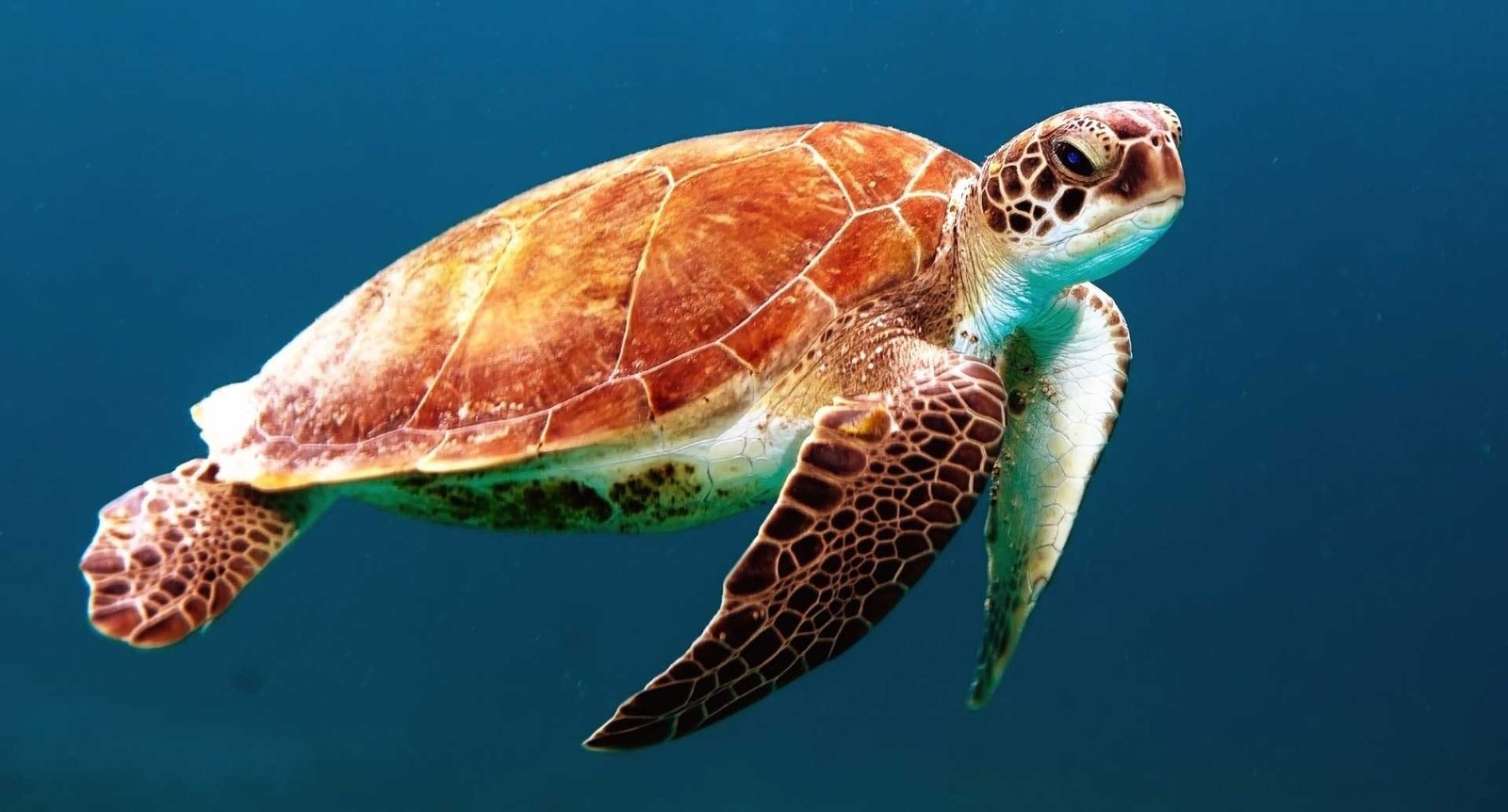The captivating story of Stitch, the large desert tortoise, begins in the arid landscapes of Arizona, where he unexpectedly found himself in a life-threatening situation on a busy highway. This extraordinary tale highlights Stitch’s remarkable escape from peril, rendering him a subject of admiration and intrigue. As the sun warmed the pavement beneath him, Stitch, named so for his unique pattern resembling a collection of stitches, meandered across the road, blissfully unaware of the danger surrounding him.
On that fateful day, numerous motorists were startled to see a tortoise navigating the asphalt, an unusual sight that quickly drew attention. Traffic slowed, and concern mounted as drivers realized the risks posed to this gentle giant. It was during this critical moment that a local hero emerged, stopping their vehicle to assist Stitch. This act of compassion marked the beginning of an adventure that would lead him away from danger and onto a ranch specializing in ostriches.
The journey that followed was nothing short of remarkable. After being safely removed from the highway, Stitch was transported to a nearby ostrich ranch, where he would be cared for until a more permanent home could be found for him. The ranch, known for its vast open spaces, provided an ideal habitat for Stitch to recover from his harrowing experience. Here, he would not only find safety but would also become a beloved figure among the ranch staff and visitors alike.
This introduction serves to set the stage for the unfolding narrative of Stitch’s adventure—an inspiring rescue that highlights the importance of both human compassion and wildlife conservation. As we dive deeper into the specifics of Stitch’s experience, we will explore the various challenges he faced and the remarkable support he received from those around him.
The Great Escape from the Ostrich Ranch
Stitch, the resilient desert tortoise, embarked on a remarkable escape from the confines of the ostrich ranch, which was situated a mere three miles away from his home territory. The conditions at the ranch often proved to be less than ideal for the wildlife it housed. With vast enclosures and minimal stimulation, Stitch likely found himself yearning for a more enriching environment. The ranch, primarily focused on raising ostriches for commercial purposes, lacked the necessary habitats conducive to the natural behaviors of various animals, including Stitch.
The inquisitive nature of tortoises suggests that they possess an innate desire to explore their surroundings. This instinct was likely heightened by the limited opportunities for adventure at the ranch. Observations of other animals, particularly the endless pacing of the ostriches, could have inspired Stitch to seek out a new realm beyond the confines of his temporary residence. His adventurous spirit may have been ignited by the chaotic energy of the large birds, drawing him to the prospect of freedom.
Additionally, it is worth noting that Stitch was not alone in his plight. The presence of other animals within the ranch could have influenced his decision to wander off. For instance, the curiosity displayed by fellow ranch-dwellers, such as the rabbits and smaller reptiles, might have prompted him to follow suit. Together, they shared the common aspiration of leaving behind an uninspiring environment. Their subtle interactions could have played a pivotal role in motivating Stitch to embark on his journey away from the ostentatious ranch.
In retrospect, the circumstances surrounding Stitch’s escape illustrate the broader significance of environmental enrichment and the importance of accommodating the natural instincts of wildlife. His flight toward freedom not only serves as a testament to his adventurous spirit but also highlights the critical need for better living conditions for animals in captivity.
The Encounter with Troopers
On a seemingly ordinary day, the tranquility of the vast desert landscape was abruptly interrupted when highway troopers on patrol stumbled upon an unexpected sight. As they drove along the roadway, their attention was drawn to a solitary figure traversing the asphalt. It was Stitch, the desert tortoise, navigating a perilous route that could potentially lead to his demise. The troopers instinctively understood the gravity of the situation, realizing the imminent dangers that a turtle facing busy traffic could encounter.
As the officers approached, they recognized the urgency of the moment. The warm desert sun beat down upon Stitch, leaving him vulnerable to the harsh elements, and the risk of being struck by a vehicle loomed large. Highway safety protocol emphasizes the importance of providing assistance to wildlife and ensuring the safe coexistence of all beings, prompting the troopers to act swiftly. They parked their vehicle strategically to shield the tortoise from oncoming traffic and alerted nearby motorists to the situation.
The troopers’ response illustrated a commendable commitment to preserving the lives of all creatures, regardless of size. As they carefully assessed the tortoise’s condition, they were acutely aware that desert tortoises are a threatened species, making each encounter of this nature critical. Their quick thinking and prompt action not only safeguarded Stitch from immediate danger but also highlighted the necessity of raising awareness about wildlife conservation efforts.
This dramatic encounter between Stitch and the highway troopers underscores the essential role that individuals can play in protecting wildlife. The urgency with which the officers responded showcases the need for vigilance and action when encountering such situations on the road. Their dedication serves as a reminder that even amidst the bustling demands of daily life, there is an imperative to prioritize the preservation of the natural world.
The Importance of Identification
Identification plays a crucial role in the care and recovery of pets and wildlife, particularly for species like the desert tortoise. In the case of Stitch, the label affixed to his shell proved instrumental in his rescue. This form of identification not only provided a means for veterinarians and rescuers to quickly ascertain Stitch’s identity but also served as a vital link to his owner. By having a recognizable label, rescuers were able to bypass the typical lengthy process of determining ownership, thus facilitating a swift return to his rightful caretaker.
Moreover, labeling pets helps prevent similar situations. For pet owners, it is advisable to use multiple identification methods. Microchipping is one effective approach, as it provides a permanent form of identification that cannot be lost or removed. Collars with ID tags should also be utilized, ensuring the tag contains the owner’s contact information. Such practices not only enhance the chances of a successful reunion following a pet’s escape or loss but also aid in the overall health management of the animal, allowing for medical history to be accessed swiftly when needed.
In the broader context of wildlife preservation, identification tags on rehabilitated animals can provide critical data for researchers and conservationists. These tags can help monitor the health, movement, and behaviors of animals like Stitch, contributing valuable information to ensure their survival in the wild. Therefore, the implementation of effective identification measures is not merely a matter of convenience; it is an essential practice that enhances the well-being of both pets and wildlife alike. The significance of identification cannot be understated—it serves as a bridge between animals and their caretakers, facilitating timely assistance and fostering responsible ownership.
The Contact with the Ostrich Ranch
After the brave rescue of Stitch, the desert tortoise, the next crucial step involved establishing communication with the nearby ostrich ranch. The local troopers, who were instrumental in locating Stitch, recognized the importance of notifying the ranch about the tortoise’s circumstances. The ranch is known for its diverse array of exotic animals, including ostriches, making it imperative to keep track of their well-being and any potential escapees.
Upon finding Stitch, the troopers promptly reached out to the ranch management. The swift response highlighted the ranch’s commitment to animal welfare and their established protocols for handling incidents involving escaping animals. Typically, these protocols involve immediate verification of the animal’s identity and a thorough assessment of its health upon recovery. Such measures ensure that the animals, once returned, are safe and monitored appropriately. The ranch staff expressed their gratitude for the troopers’ diligence and ensured that they would prepare to receive Stitch without delay.
The ranch had detailed procedures in place for situations like this, which included the identification process of any lost animals. They emphasize that timely communication combined with necessary protocols is paramount to preserving the welfare of their animals. Following the report from the troopers, the ranch quickly mobilized a team to reunite with Stitch. The assembly of knowledgeable staff, equipped with the right tools for handling desert tortoises, ensured that the reunification process proceeded smoothly.
Overall, the cooperation between the troopers and the ostrich ranch exemplifies a commendable partnership dedicated to the welfare of the animals in their care, showcasing the importance of swift communication in animal rescue efforts.
Stitch’s Condition Post-Rescue
Upon being rescued from the highway, Stitch, the desert tortoise, was immediately assessed for injuries and overall wellbeing by wildlife authorities and veterinarians. The initial examination revealed several minor abrasions and signs of dehydration, which are not uncommon in tortoises subjected to stressful conditions. Fortunately, no severe injuries were documented, which indicated that Stitch had managed to escape critical harm despite the dangers of the busy highway.
Stitch’s dehydration was a pressing concern, particularly considering the harsh desert environment from which he originated. As reptiles, tortoises require a specific level of hydration to maintain their bodily functions. To address this, the wildlife team initiated a rehydration plan, providing Stitch with a controlled intake of water and a specialized diet rich in moisture to facilitate recovery. Supplementing his diet with leafy greens and other hydrating food sources was crucial during this recovery period.
The care provided by the authorities was comprehensive. They placed Stitch in a temperature-controlled environment to mitigate stress and promote healing. Over the subsequent days, significant improvements in his health were observed. Stitch began to regain his appetite and showed signs of activity, important indicators of a tortoise’s overall wellbeing. Regular monitoring ensured that any changes in his condition were swiftly addressed, allowing for a positive trajectory in his recovery.
During this critical period, specialists also educated the public on the need for awareness of desert tortoises in their natural habitat, emphasizing their vulnerability to roadside dangers. This experience highlighted not only the immediate needs of Stitch but also reinforced the importance of protecting such wildlife. Therefore, while he faced challenges post-rescue, the dedicated care facilitated by the team ensured Stitch was on the path to recovery, setting the stage for a return to his natural environment when ready. In summary, the blend of proper medical attention and a nurturing environment played a vital role in Stitch’s recovery process following his rescue.
Community Support and Reactions
The story of Stitch, the desert tortoise who faced challenging circumstances, has garnered significant attention from the local community as well as from animal lovers around the globe. The collective response to this heroic rescue has been overwhelmingly positive, showcasing the strength and compassion within the community. Social media platforms buzzed with posts that not only shared Stitch’s journey but also provided updates about his well-being.
Hashtags dedicated to Stitch’s rescue trended on various social media platforms, amplifying the message of support for all endangered species. Users shared images, videos, and personal anecdotes reflecting their admiration for Stitch’s resilience. Comments flooded in from individuals expressing their hope and concern for the tortoise, thereby fostering a sense of unity and shared purpose among followers. These interactions helped to raise awareness about desert tortoises and the challenges they face in the wild, ultimately emphasizing the importance of conservation efforts.
Moreover, community events were organized where local residents gathered to advocate for wildlife preservation. Fundraisers were conducted, with proceeds directed toward organizations dedicated to preserving the natural habitats of desert tortoises. The unified efforts of the community illustrated how a single animal’s plight could ignite a dialogue about ecological responsibilities and inspire actions aimed at safeguarding fragile ecosystems.
The remarkable compassion exhibited by the public did not stop at virtual support; it extended to tangible actions that further solidified the community’s dedication to Stitch’s well-being. Animal rescue groups reported an influx of volunteers and donations during this time, proving that the interest in Stitch’s narrative not only resonated with the hearts of many but also sparked active participation in wildlife protection.
Lessons Learned from Stitch’s Journey
The remarkable journey of Stitch, the desert tortoise, offers several invaluable lessons that can be applied to pet ownership, wildlife conservation, and road safety. One of the most significant takeaways is the necessity of secure enclosures for pets. Many pet owners may not realize the potential dangers that exist beyond their backyard, whether it be from predators, vehicles, or even harsh weather conditions. Ensuring that pets have a properly secured habitat can prevent them from wandering off and facing perilous situations akin to those experienced by Stitch.
Another critical lesson from Stitch’s adventure relates to the consciousness of wildlife habitats. As human development expands, many natural habitats are encroached upon, resulting in increased interactions between domestic pets and wildlife. Understanding the ecosystems in which both pets and wild animals coexist is imperative. Wildlife habitats often serve as migration routes, food sources, and territories for many species. Awareness of these areas can foster better coexistence and protect vulnerable species, such as the desert tortoise, from unnecessary confrontations and road hazards.
Moreover, Stitch’s perilous journey highlights broader implications for animal safety, particularly on highways. As traffic volume increases, animals frequently attempt to cross roads, leading to tragic outcomes. Communities must prioritize creating wildlife corridors and implementing signage to alert drivers of wildlife crossings. These measures can significantly reduce roadkill incidents, fostering a safer environment for both local fauna and human travelers. Additionally, public education campaigns emphasizing the importance of observing speed limits in wildlife-heavy areas may serve as a deterrent against accidents involving wildlife.
Ultimately, the story of Stitch exemplifies a myriad of lessons regarding responsible pet ownership, wildlife conservation, and enhancing road safety. By incorporating these insights, individuals can not only protect their animals but also contribute to a more harmonious existence among all species.
Future for Stitch: Homeward Bound
Following his heroic rescue, the future of Stitch, the desert tortoise, looks promising as various options are considered for his rehabilitation and eventual placement. Upon assessment of his health and behavior, it was determined that returning him to his original habitat at the ranch is a viable option. The ranch management, however, is also contemplating establishing a sanctuary area specifically designed to accommodate rescued tortoises. This sanctuary would enable Stitch, along with any other rehabilitated tortoises, to thrive in a safe environment while minimizing the risk of future escapes.
In addition to the standard protocols for returning reptiles to their natural habitat, the ranch intends to implement enhanced security measures to prevent any similar escapades in the future. This includes the installation of more robust fencing and regular inspections of the barriers surrounding the ranch. These steps are crucial, not only for Stitch’s safety but also for the well-being of all the creatures residing at the ranch.
Moreover, the ranch is engaging with local wildlife experts to create educational programs that promote awareness about the needs of desert tortoises and the importance of proper care. By collaborating with communities, the ranch hopes to foster a sense of responsibility amongst pet owners to ensure the health and safety of their tortoise companions. If Stitch is not returned to the ranch, there are potential families interested in adopting him, who have taken steps to assure that they can provide a nurturing environment suitable for his needs.
Ultimately, no matter which path is chosen for Stitch, the emphasis is placed on his welfare and the need for proactive measures that protect tortoises in the broader ecological community. Coordinated efforts will be essential as we move forward to ensure a future where the tortoise population remains thriving and secure.













Leave feedback about this